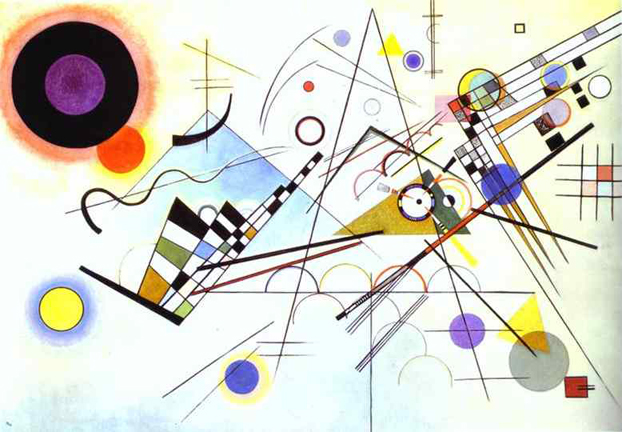Open Culture posted this the other day on the occasion of Kandinsky's 145th birthday (December 16). Kandisnky has long been one of my favorite artists, so this was fun to watch.
The Inner Object: Seeing Kandinsky
Today is the birthday of the Russian abstract painter and art theorist Wassily Kandinsky. He was born in Moscow on December 16, 1866 (December 4 on the Julian calendar), and raised in Odessa, where he took an early interest in music. As a young man he studied economics and law, but in 1895 his life was forever changed when he attended a Moscow exhibition of paintings by the French Impressionists. Kandinsky was deeply struck by one of Monet’s paintings from the series Haystacks at Giverny. He later recalled his epiphany:
That it was a haystack the catalogue informed me. I could not recognize it. This non-recognition was painful to me. I considered that the painter had no right to paint indistinctly. I dully felt that the object of the painting was missing. And I noticed with surprise and confusion that the picture not only gripped me, but impressed itself ineradicably on my memory. Painting took on a fairy-tale power and splendor.
Kandinsky quit his job as a law professor and dedicated himself to painting. He emigrated, first to France and then to Germany, where he moved further and further away from figurative painting. He was among the first to create works that were completely abstract, or non-objective. In his 1910 treatise, Concerning the Spiritual in Art, Kandinsky declares that the elements within a painting should not correspond to any outer object, but only to the artist’s “inner need.”
In observance of the artist’s 145th birthday, we present two videos with different perspectives on his work. Above, actress Helen Mirren talks with the Museum of Modern Art about what Kandinsky, and art, mean to her. Below, a trio of scholars–Beth Harris, Juliana Kreinik and Steven Zucker–discuss Kandinsky’s 1913 masterpiece, “Composition VII,” for the Khan Academy’s Smarthistory series. “Composition VII” was painted by Kandinsky in Munich over a period of four days–but only after he had made more than 30 preparatory sketches, watercolors and oil studies.
Kandinsky, Composition VII, 1913 from Smarthistory Videos on Vimeo.
Related Content
MoMA Puts Pollock, Rothko & de Kooning on Your iPad
Jackson Pollock: Lights, Camera, Paint! (1951)
John Berger’s Ways of Seeing: The TV Series

No comments:
Post a Comment